brake light PONTIAC GRAND PRIX 2004 User Guide
[x] Cancel search | Manufacturer: PONTIAC, Model Year: 2004, Model line: GRAND PRIX, Model: PONTIAC GRAND PRIX 2004Pages: 432, PDF Size: 2.99 MB
Page 245 of 432
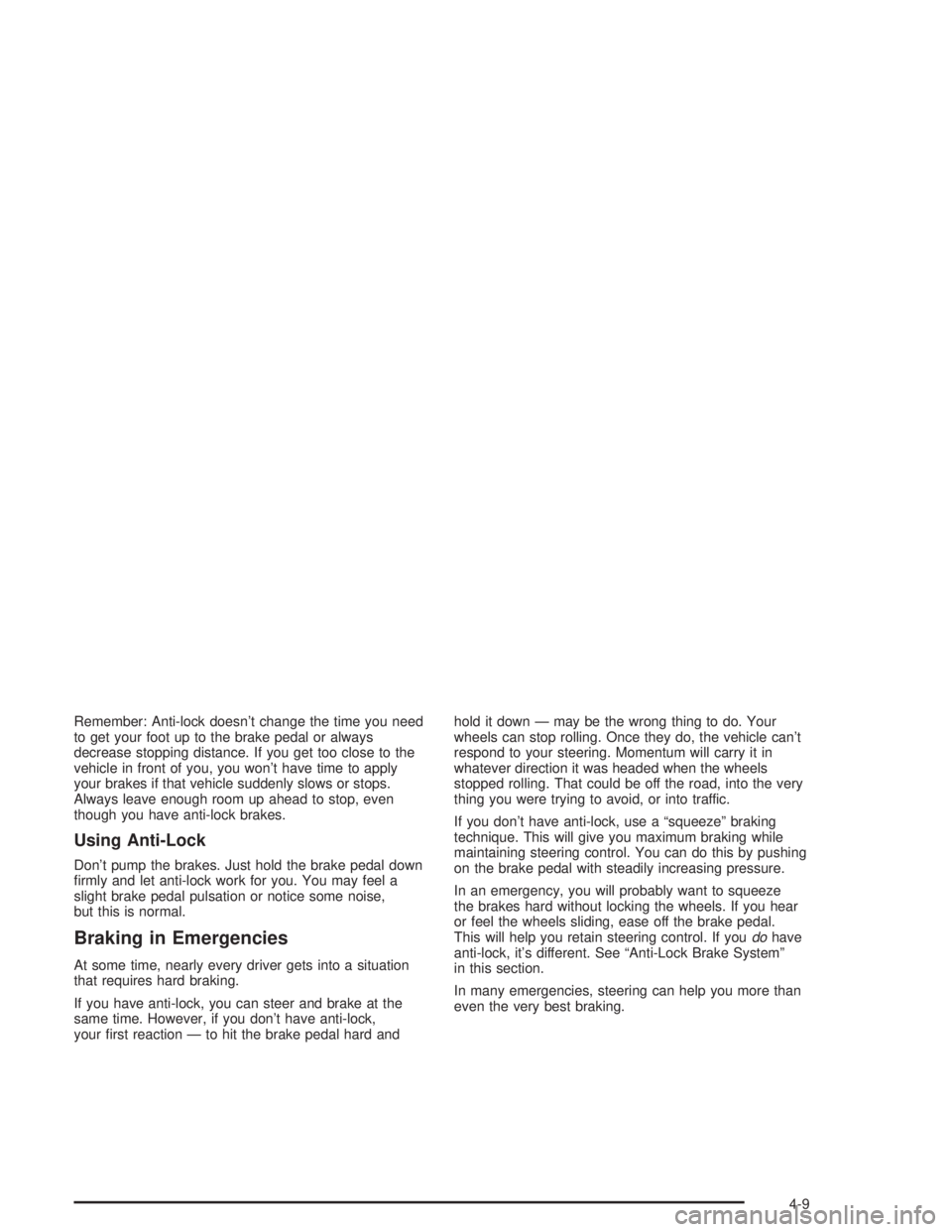
Remember: Anti-lock doesn't change the time you need
to get your foot up to the brake pedal or always
decrease stopping distance. If you get too close to the
vehicle in front of you, you won't have time to apply
your brakes if that vehicle suddenly slows or stops.
Always leave enough room up ahead to stop, even
though you have anti-lock brakes.
Using Anti-Lock
Don't pump the brakes. Just hold the brake pedal down
®rmly and let anti-lock work for you. You may feel a
slight brake pedal pulsation or notice some noise,
but this is normal.
Braking in Emergencies
At some time, nearly every driver gets into a situation
that requires hard braking.
If you have anti-lock, you can steer and brake at the
same time. However, if you don't have anti-lock,
your ®rst reaction Ð to hit the brake pedal hard andhold it down Ð may be the wrong thing to do. Your
wheels can stop rolling. Once they do, the vehicle can't
respond to your steering. Momentum will carry it in
whatever direction it was headed when the wheels
stopped rolling. That could be off the road, into the very
thing you were trying to avoid, or into traffic.
If you don't have anti-lock, use a ªsqueezeº braking
technique. This will give you maximum braking while
maintaining steering control. You can do this by pushing
on the brake pedal with steadily increasing pressure.
In an emergency, you will probably want to squeeze
the brakes hard without locking the wheels. If you hear
or feel the wheels sliding, ease off the brake pedal.
This will help you retain steering control. If you
dohave
anti-lock, it's different. See ªAnti-Lock Brake Systemº
in this section.
In many emergencies, steering can help you more than
even the very best braking.
4-9
Page 257 of 432
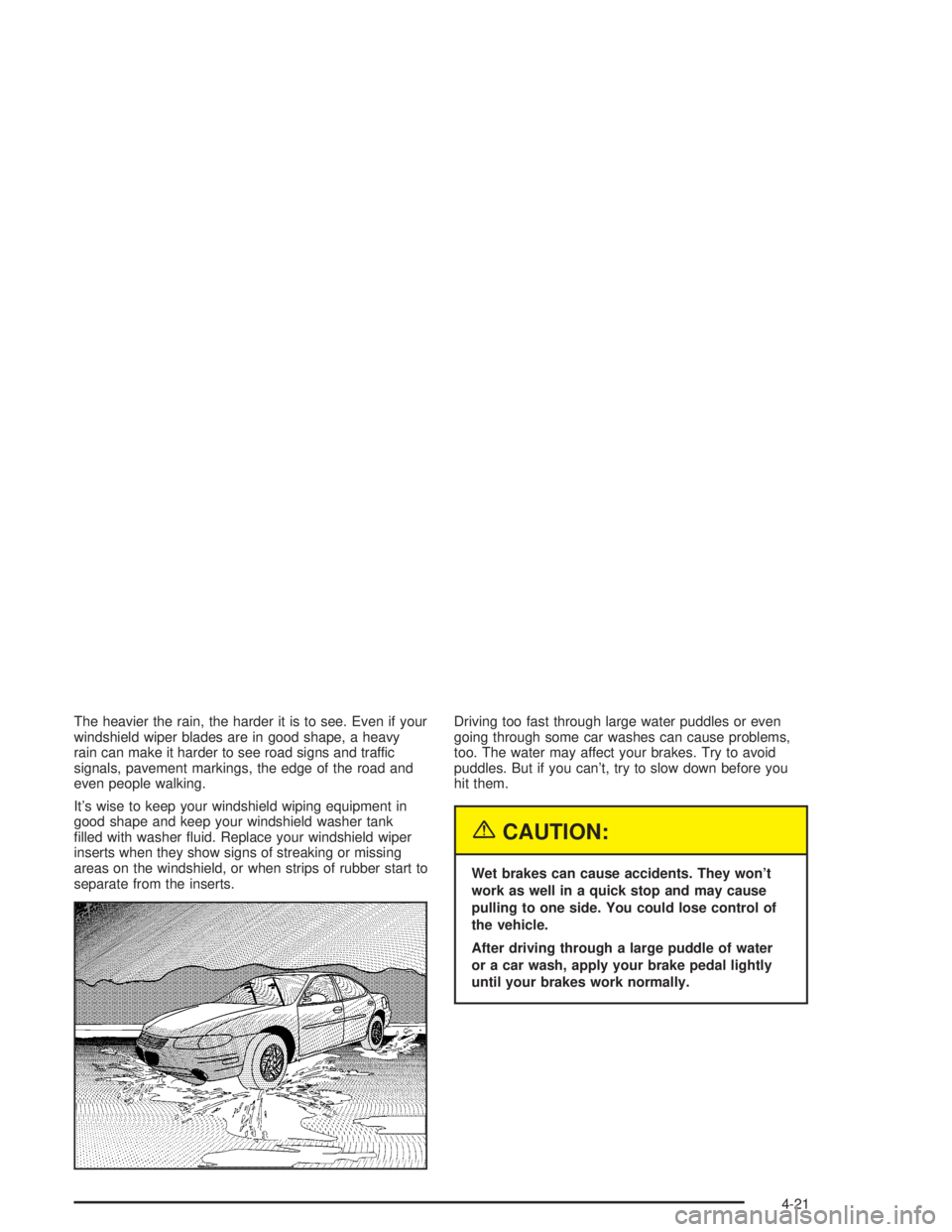
The heavier the rain, the harder it is to see. Even if your
windshield wiper blades are in good shape, a heavy
rain can make it harder to see road signs and traffic
signals, pavement markings, the edge of the road and
even people walking.
It's wise to keep your windshield wiping equipment in
good shape and keep your windshield washer tank
®lled with washer ¯uid. Replace your windshield wiper
inserts when they show signs of streaking or missing
areas on the windshield, or when strips of rubber start to
separate from the inserts.Driving too fast through large water puddles or even
going through some car washes can cause problems,
too. The water may affect your brakes. Try to avoid
puddles. But if you can't, try to slow down before you
hit them.
{CAUTION:
Wet brakes can cause accidents. They won't
work as well in a quick stop and may cause
pulling to one side. You could lose control of
the vehicle.
After driving through a large puddle of water
or a car wash, apply your brake pedal lightly
until your brakes work normally.
4-21
Page 278 of 432
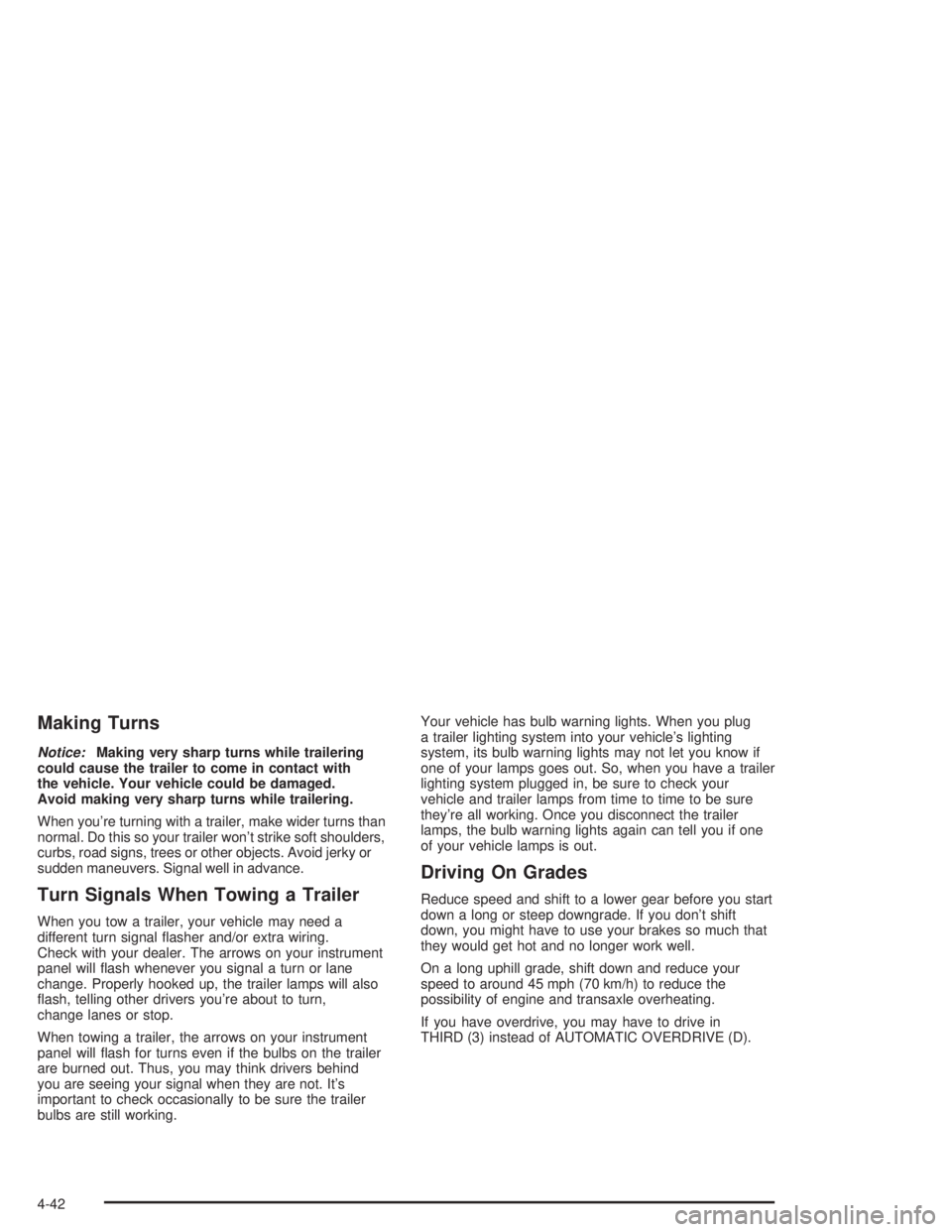
Making Turns
Notice:Making very sharp turns while trailering
could cause the trailer to come in contact with
the vehicle. Your vehicle could be damaged.
Avoid making very sharp turns while trailering.
When you're turning with a trailer, make wider turns than
normal. Do this so your trailer won't strike soft shoulders,
curbs, road signs, trees or other objects. Avoid jerky or
sudden maneuvers. Signal well in advance.
Turn Signals When Towing a Trailer
When you tow a trailer, your vehicle may need a
different turn signal ¯asher and/or extra wiring.
Check with your dealer. The arrows on your instrument
panel will ¯ash whenever you signal a turn or lane
change. Properly hooked up, the trailer lamps will also
¯ash, telling other drivers you're about to turn,
change lanes or stop.
When towing a trailer, the arrows on your instrument
panel will ¯ash for turns even if the bulbs on the trailer
are burned out. Thus, you may think drivers behind
you are seeing your signal when they are not. It's
important to check occasionally to be sure the trailer
bulbs are still working.Your vehicle has bulb warning lights. When you plug
a trailer lighting system into your vehicle's lighting
system, its bulb warning lights may not let you know if
one of your lamps goes out. So, when you have a trailer
lighting system plugged in, be sure to check your
vehicle and trailer lamps from time to time to be sure
they're all working. Once you disconnect the trailer
lamps, the bulb warning lights again can tell you if one
of your vehicle lamps is out.
Driving On Grades
Reduce speed and shift to a lower gear before you start
down a long or steep downgrade. If you don't shift
down, you might have to use your brakes so much that
they would get hot and no longer work well.
On a long uphill grade, shift down and reduce your
speed to around 45 mph (70 km/h) to reduce the
possibility of engine and transaxle overheating.
If you have overdrive, you may have to drive in
THIRD (3) instead of AUTOMATIC OVERDRIVE (D).
4-42
Page 326 of 432
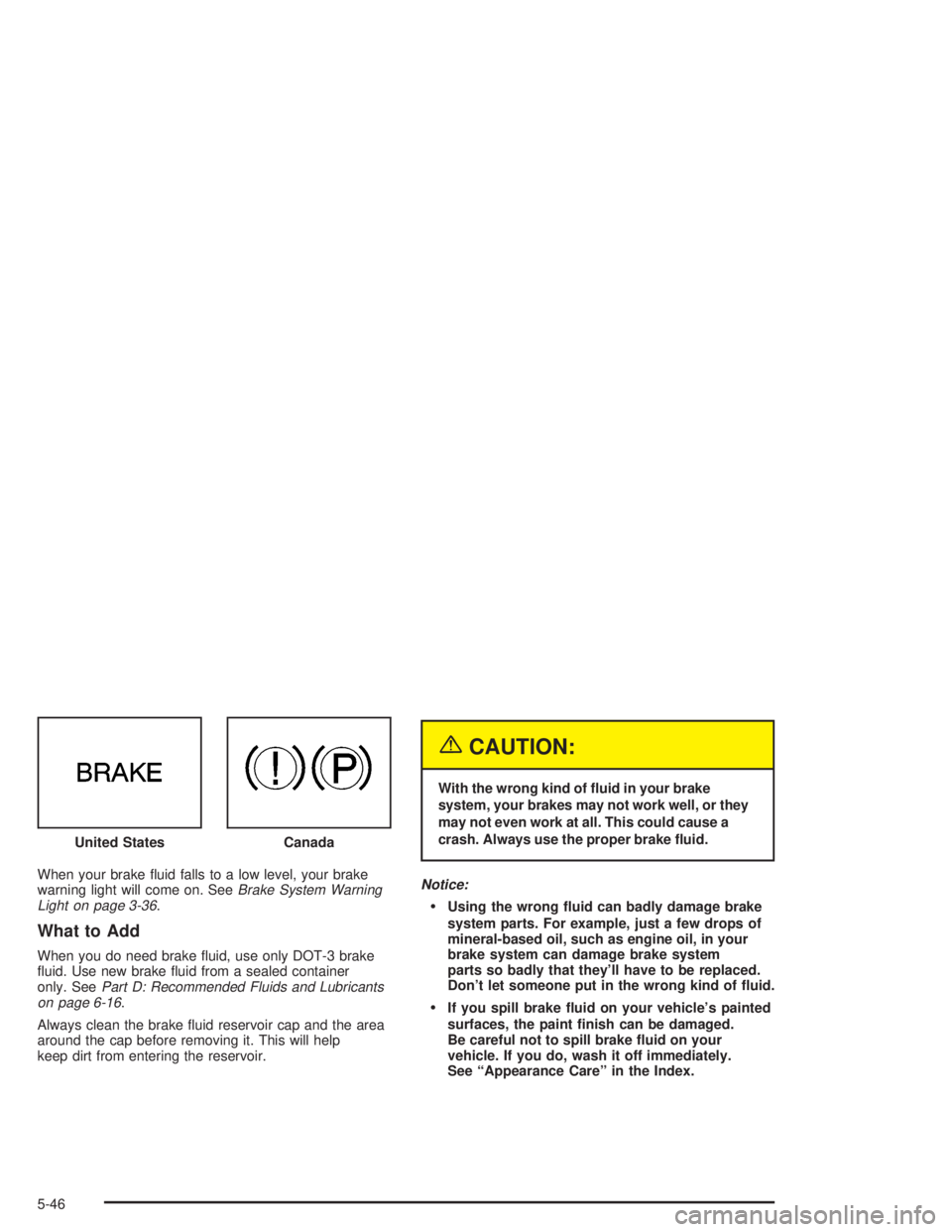
When your brake ¯uid falls to a low level, your brake
warning light will come on. SeeBrake System Warning
Light on page 3-36.
What to Add
When you do need brake ¯uid, use only DOT-3 brake
¯uid. Use new brake ¯uid from a sealed container
only. See
Part D: Recommended Fluids and Lubricants
on page 6-16.
Always clean the brake ¯uid reservoir cap and the area
around the cap before removing it. This will help
keep dirt from entering the reservoir.
{CAUTION:
With the wrong kind of ¯uid in your brake
system, your brakes may not work well, or they
may not even work at all. This could cause a
crash. Always use the proper brake ¯uid.
Notice:
·Using the wrong ¯uid can badly damage brake
system parts. For example, just a few drops of
mineral-based oil, such as engine oil, in your
brake system can damage brake system
parts so badly that they'll have to be replaced.
Don't let someone put in the wrong kind of ¯uid.
·If you spill brake ¯uid on your vehicle's painted
surfaces, the paint ®nish can be damaged.
Be careful not to spill brake ¯uid on your
vehicle. If you do, wash it off immediately.
See ªAppearance Careº in the Index. United States
Canada
5-46
Page 327 of 432
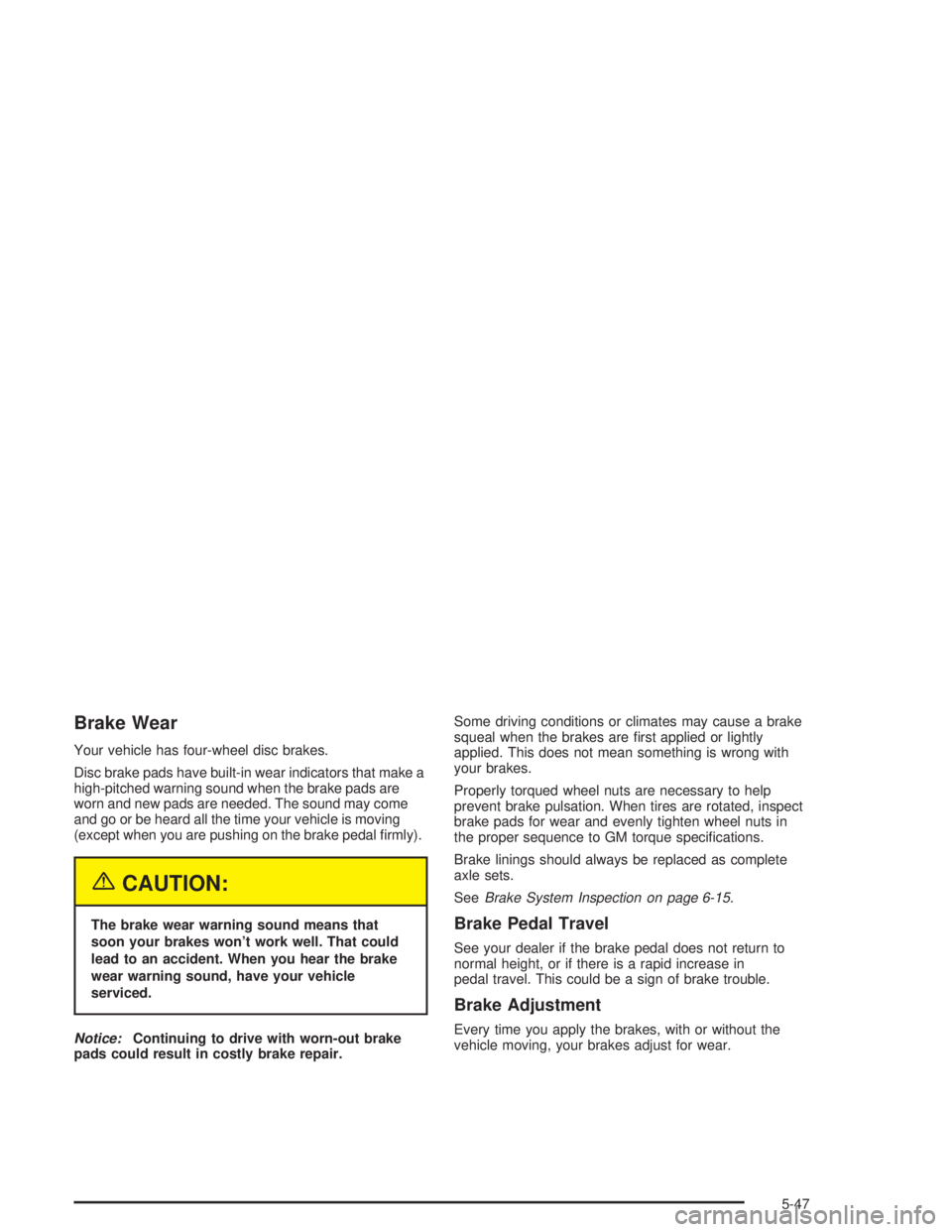
Brake Wear
Your vehicle has four-wheel disc brakes.
Disc brake pads have built-in wear indicators that make a
high-pitched warning sound when the brake pads are
worn and new pads are needed. The sound may come
and go or be heard all the time your vehicle is moving
(except when you are pushing on the brake pedal ®rmly).
{CAUTION:
The brake wear warning sound means that
soon your brakes won't work well. That could
lead to an accident. When you hear the brake
wear warning sound, have your vehicle
serviced.
Notice:Continuing to drive with worn-out brake
pads could result in costly brake repair.Some driving conditions or climates may cause a brake
squeal when the brakes are ®rst applied or lightly
applied. This does not mean something is wrong with
your brakes.
Properly torqued wheel nuts are necessary to help
prevent brake pulsation. When tires are rotated, inspect
brake pads for wear and evenly tighten wheel nuts in
the proper sequence to GM torque speci®cations.
Brake linings should always be replaced as complete
axle sets.
See
Brake System Inspection on page 6-15.
Brake Pedal Travel
See your dealer if the brake pedal does not return to
normal height, or if there is a rapid increase in
pedal travel. This could be a sign of brake trouble.
Brake Adjustment
Every time you apply the brakes, with or without the
vehicle moving, your brakes adjust for wear.
5-47
Page 391 of 432
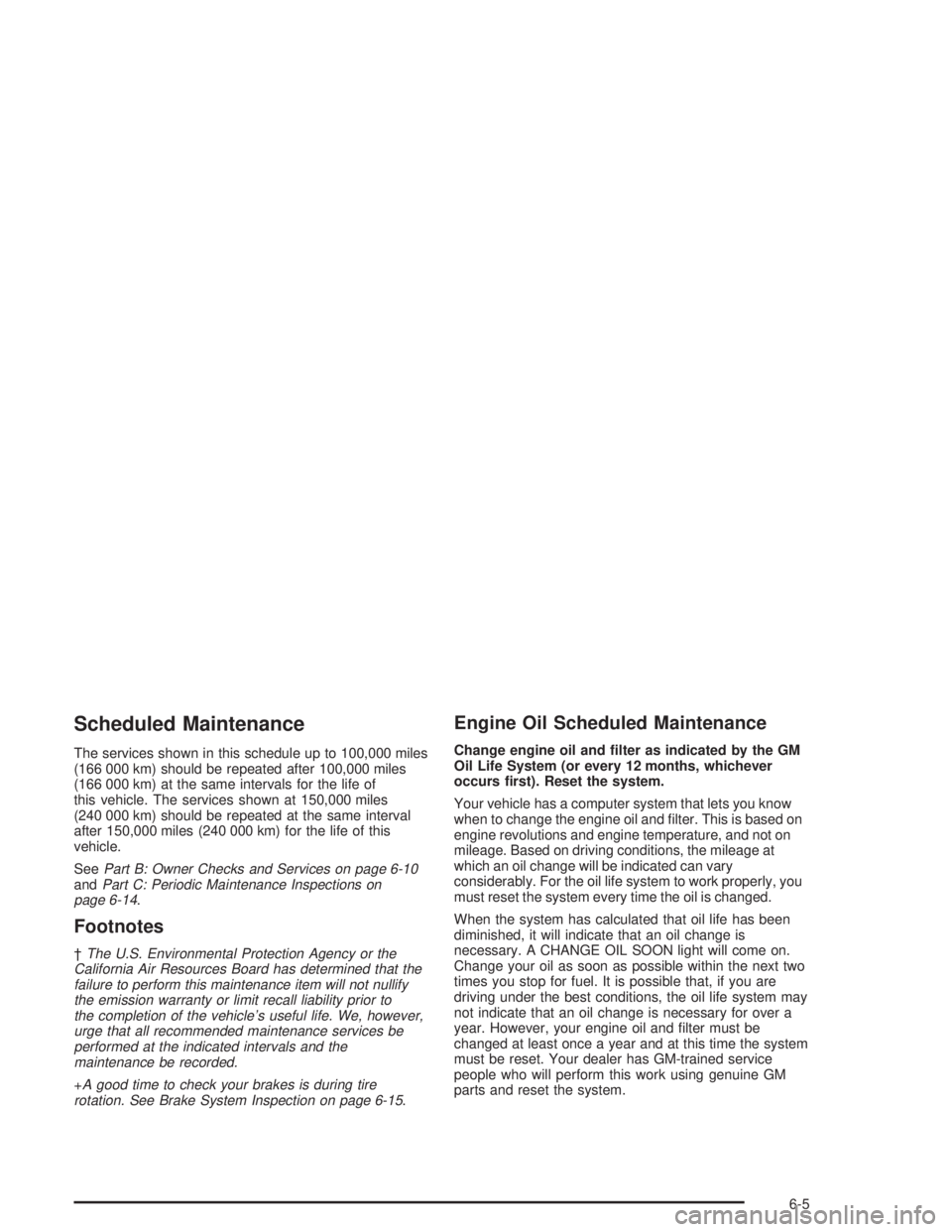
Scheduled Maintenance
The services shown in this schedule up to 100,000 miles
(166 000 km) should be repeated after 100,000 miles
(166 000 km) at the same intervals for the life of
this vehicle. The services shown at 150,000 miles
(240 000 km) should be repeated at the same interval
after 150,000 miles (240 000 km) for the life of this
vehicle.
See
Part B: Owner Checks and Services on page 6-10andPart C: Periodic Maintenance Inspections on
page 6-14.
Footnotes
²The U.S. Environmental Protection Agency or the
California Air Resources Board has determined that the
failure to perform this maintenance item will not nullify
the emission warranty or limit recall liability prior to
the completion of the vehicle's useful life. We, however,
urge that all recommended maintenance services be
performed at the indicated intervals and the
maintenance be recorded.
+A good time to check your brakes is during tire
rotation. See Brake System Inspection on page 6-15.
Engine Oil Scheduled Maintenance
Change engine oil and ®lter as indicated by the GM
Oil Life System (or every 12 months, whichever
occurs ®rst). Reset the system.
Your vehicle has a computer system that lets you know
when to change the engine oil and ®lter. This is based on
engine revolutions and engine temperature, and not on
mileage. Based on driving conditions, the mileage at
which an oil change will be indicated can vary
considerably. For the oil life system to work properly, you
must reset the system every time the oil is changed.
When the system has calculated that oil life has been
diminished, it will indicate that an oil change is
necessary. A CHANGE OIL SOON light will come on.
Change your oil as soon as possible within the next two
times you stop for fuel. It is possible that, if you are
driving under the best conditions, the oil life system may
not indicate that an oil change is necessary for over a
year. However, your engine oil and ®lter must be
changed at least once a year and at this time the system
must be reset. Your dealer has GM-trained service
people who will perform this work using genuine GM
parts and reset the system.
6-5
Page 417 of 432
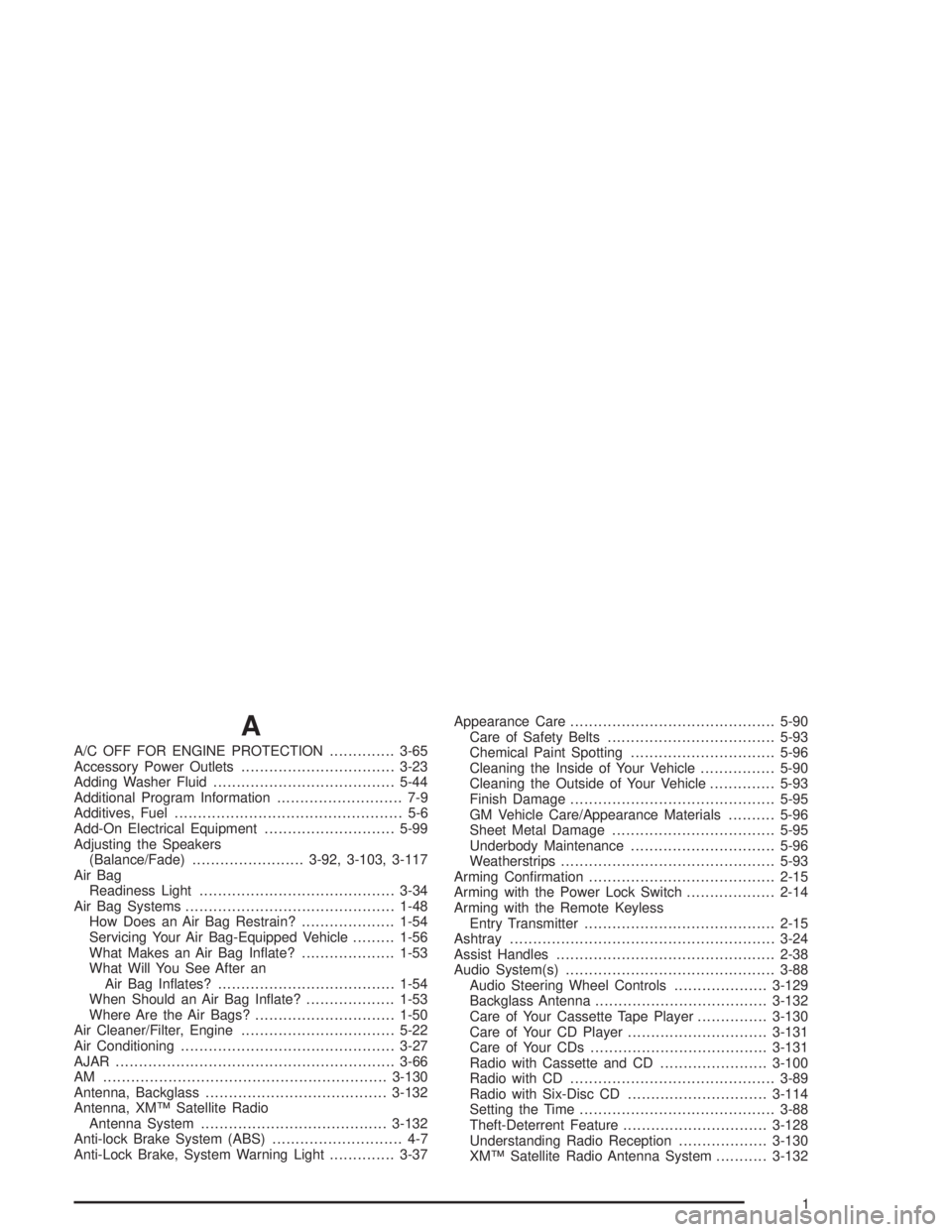
A
A/C OFF FOR ENGINE PROTECTION..............3-65
Accessory Power Outlets.................................3-23
Adding Washer Fluid.......................................5-44
Additional Program Information........................... 7-9
Additives, Fuel................................................. 5-6
Add-On Electrical Equipment............................5-99
Adjusting the Speakers
(Balance/Fade)........................3-92, 3-103, 3-117
Air Bag
Readiness Light..........................................3-34
Air Bag Systems.............................................1-48
How Does an Air Bag Restrain?....................1-54
Servicing Your Air Bag-Equipped Vehicle.........1-56
What Makes an Air Bag In¯ate?....................1-53
What Will You See After an
Air Bag In¯ates?......................................1-54
When Should an Air Bag In¯ate?...................1-53
Where Are the Air Bags?..............................1-50
Air Cleaner/Filter, Engine.................................5-22
Air Conditioning..............................................3-27
AJAR............................................................3-66
AM .............................................................3-130
Antenna, Backglass.......................................3-132
Antenna, XMŸ Satellite Radio
Antenna System........................................3-132
Anti-lock Brake System (ABS)............................ 4-7
Anti-Lock Brake, System Warning Light..............3-37Appearance Care............................................5-90
Care of Safety Belts....................................5-93
Chemical Paint Spotting...............................5-96
Cleaning the Inside of Your Vehicle................5-90
Cleaning the Outside of Your Vehicle..............5-93
Finish Damage............................................5-95
GM Vehicle Care/Appearance Materials..........5-96
Sheet Metal Damage...................................5-95
Underbody Maintenance...............................5-96
Weatherstrips..............................................5-93
Arming Con®rmation........................................2-15
Arming with the Power Lock Switch...................2-14
Arming with the Remote Keyless
Entry Transmitter.........................................2-15
Ashtray.........................................................3-24
Assist Handles...............................................2-38
Audio System(s).............................................3-88
Audio Steering Wheel Controls....................3-129
Backglass Antenna.....................................3-132
Care of Your Cassette Tape Player...............3-130
Care of Your CD Player..............................3-131
Care of Your CDs......................................3-131
Radio with Cassette and CD.......................3-100
Radio with CD............................................3-89
Radio with Six-Disc CD..............................3-114
Setting the Time..........................................3-88
Theft-Deterrent Feature...............................3-128
Understanding Radio Reception...................3-130
XMŸ Satellite Radio Antenna System...........3-132
1
Page 418 of 432
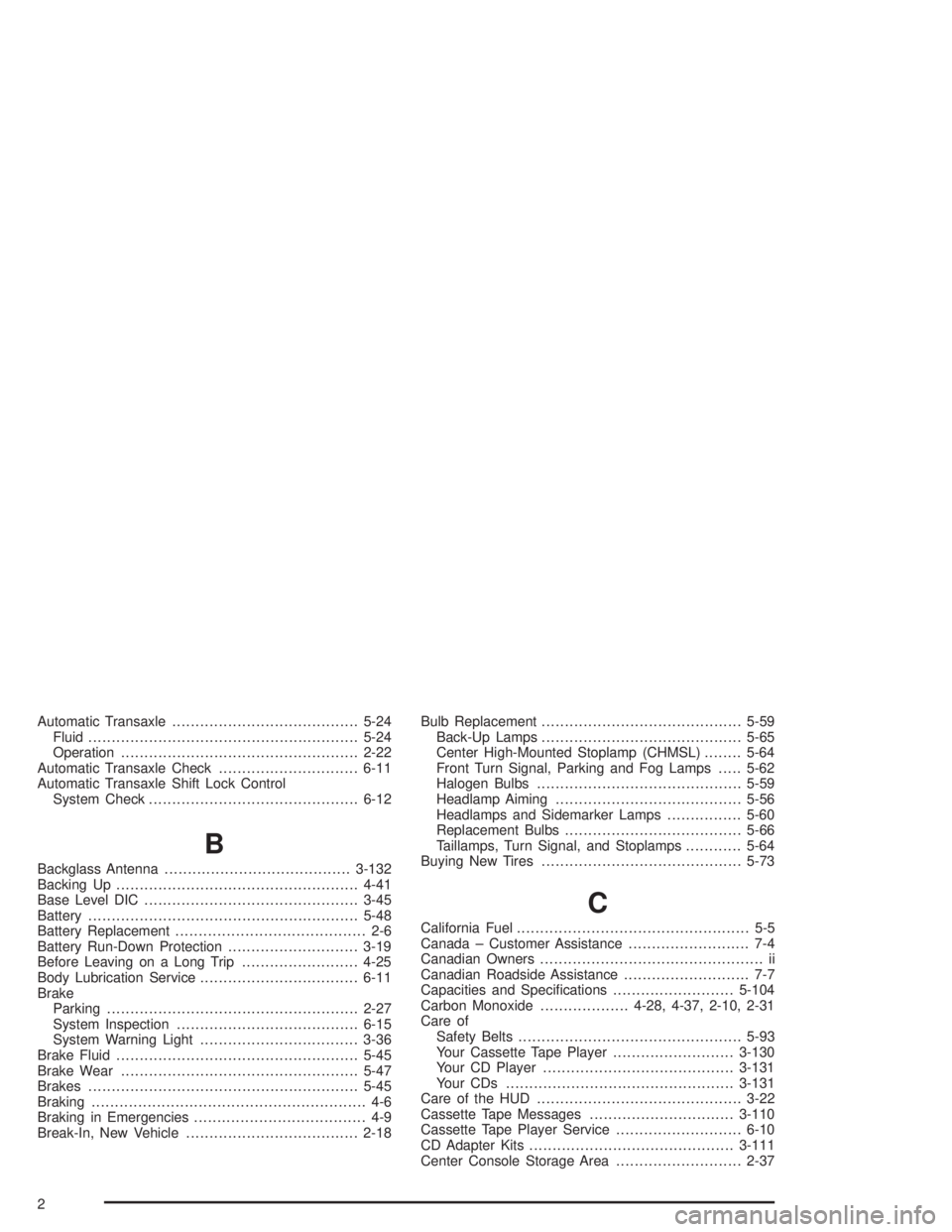
Automatic Transaxle........................................5-24
Fluid..........................................................5-24
Operation...................................................2-22
Automatic Transaxle Check..............................6-11
Automatic Transaxle Shift Lock Control
System Check.............................................6-12
B
Backglass Antenna........................................3-132
Backing Up....................................................4-41
Base Level DIC..............................................3-45
Battery..........................................................5-48
Battery Replacement......................................... 2-6
Battery Run-Down Protection............................3-19
Before Leaving on a Long Trip.........................4-25
Body Lubrication Service..................................6-11
Brake
Parking......................................................2-27
System Inspection.......................................6-15
System Warning Light..................................3-36
Brake Fluid....................................................5-45
Brake Wear...................................................5-47
Brakes..........................................................5-45
Braking........................................................... 4-6
Braking in Emergencies..................................... 4-9
Break-In, New Vehicle.....................................2-18Bulb Replacement...........................................5-59
Back-Up Lamps...........................................5-65
Center High-Mounted Stoplamp (CHMSL)........5-64
Front Turn Signal, Parking and Fog Lamps.....5-62
Halogen Bulbs............................................5-59
Headlamp Aiming........................................5-56
Headlamps and Sidemarker Lamps................5-60
Replacement Bulbs......................................5-66
Taillamps, Turn Signal, and Stoplamps............5-64
Buying New Tires...........................................5-73
C
California Fuel.................................................. 5-5
Canada ± Customer Assistance.......................... 7-4
Canadian Owners................................................ ii
Canadian Roadside Assistance........................... 7-7
Capacities and Speci®cations..........................5-104
Carbon Monoxide...................4-28, 4-37, 2-10, 2-31
Care of
Safety Belts................................................5-93
Your Cassette Tape Player..........................3-130
Your CD Player.........................................3-131
Your CDs .................................................3-131
Care of the HUD............................................3-22
Cassette Tape Messages...............................3-110
Cassette Tape Player Service...........................6-10
CD Adapter Kits............................................3-111
Center Console Storage Area...........................2-37
2
Page 423 of 432
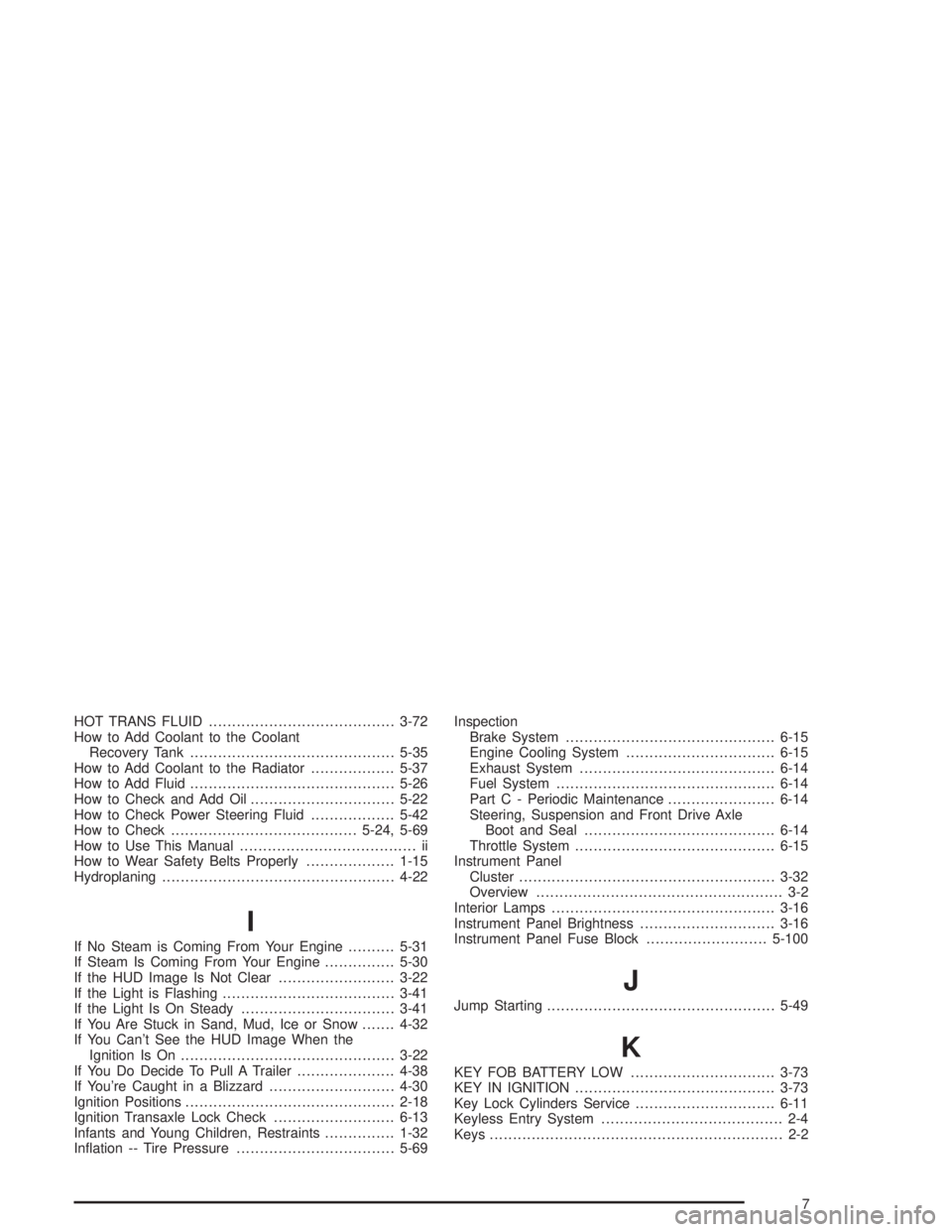
HOT TRANS FLUID........................................3-72
How to Add Coolant to the Coolant
Recovery Tank............................................5-35
How to Add Coolant to the Radiator..................5-37
How to Add Fluid............................................5-26
How to Check and Add Oil...............................5-22
How to Check Power Steering Fluid..................5-42
How to Check........................................5-24, 5-69
How to Use This Manual...................................... ii
How to Wear Safety Belts Properly...................1-15
Hydroplaning..................................................4-22
I
If No Steam is Coming From Your Engine..........5-31
If Steam Is Coming From Your Engine...............5-30
If the HUD Image Is Not Clear.........................3-22
If the Light is Flashing.....................................3-41
If the Light Is On Steady.................................3-41
If You Are Stuck in Sand, Mud, Ice or Snow.......4-32
If You Can't See the HUD Image When the
Ignition Is On..............................................3-22
If You Do Decide To Pull A Trailer.....................4-38
If You're Caught in a Blizzard...........................4-30
Ignition Positions.............................................2-18
Ignition Transaxle Lock Check..........................6-13
Infants and Young Children, Restraints...............1-32
In¯ation -- Tire Pressure..................................5-69Inspection
Brake System.............................................6-15
Engine Cooling System................................6-15
Exhaust System..........................................6-14
Fuel System...............................................6-14
Part C - Periodic Maintenance.......................6-14
Steering, Suspension and Front Drive Axle
Boot and Seal.........................................6-14
Throttle System...........................................6-15
Instrument Panel
Cluster.......................................................3-32
Overview..................................................... 3-2
Interior Lamps................................................3-16
Instrument Panel Brightness.............................3-16
Instrument Panel Fuse Block..........................5-100
J
Jump Starting.................................................5-49
K
KEY FOB BATTERY LOW...............................3-73
KEY IN IGNITION...........................................3-73
Key Lock Cylinders Service..............................6-11
Keyless Entry System....................................... 2-4
Keys............................................................... 2-2
7
Page 424 of 432
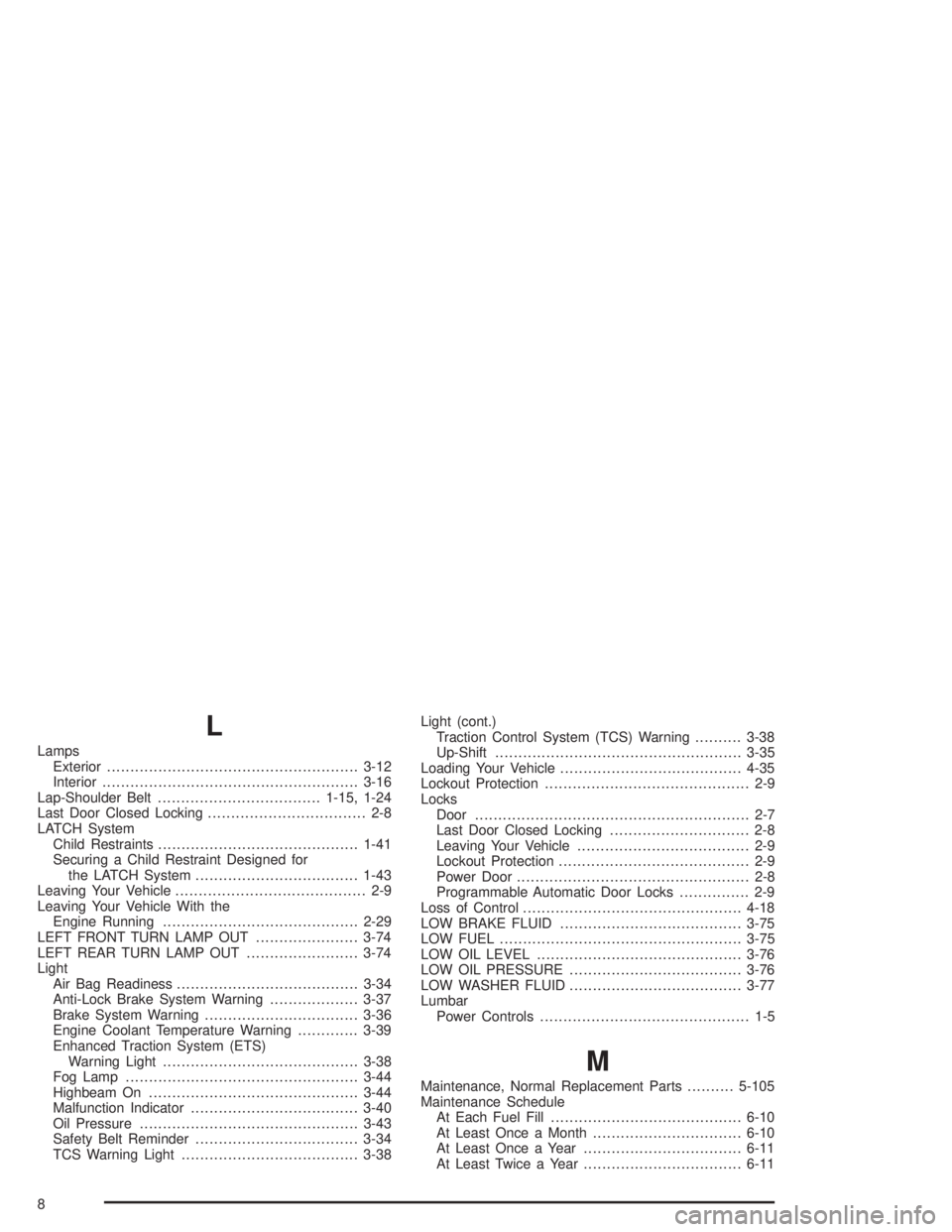
L
Lamps
Exterior......................................................3-12
Interior.......................................................3-16
Lap-Shoulder Belt...................................1-15, 1-24
Last Door Closed Locking.................................. 2-8
LATCH System
Child Restraints...........................................1-41
Securing a Child Restraint Designed for
the LATCH System...................................1-43
Leaving Your Vehicle......................................... 2-9
Leaving Your Vehicle With the
Engine Running..........................................2-29
LEFT FRONT TURN LAMP OUT......................3-74
LEFT REAR TURN LAMP OUT........................3-74
Light
Air Bag Readiness.......................................3-34
Anti-Lock Brake System Warning...................3-37
Brake System Warning.................................3-36
Engine Coolant Temperature Warning.............3-39
Enhanced Traction System (ETS)
Warning Light..........................................3-38
Fog Lamp..................................................3-44
Highbeam On.............................................3-44
Malfunction Indicator....................................3-40
Oil Pressure...............................................3-43
Safety Belt Reminder...................................3-34
TCS Warning Light......................................3-38Light (cont.)
Traction Control System (TCS) Warning..........3-38
Up-Shift.....................................................3-35
Loading Your Vehicle.......................................4-35
Lockout Protection............................................ 2-9
Locks
Door........................................................... 2-7
Last Door Closed Locking.............................. 2-8
Leaving Your Vehicle..................................... 2-9
Lockout Protection......................................... 2-9
Power Door.................................................. 2-8
Programmable Automatic Door Locks............... 2-9
Loss of Control...............................................4-18
LOW BRAKE FLUID.......................................3-75
LOW FUEL....................................................3-75
LOW OIL LEVEL............................................3-76
LOW OIL PRESSURE.....................................3-76
LOW WASHER FLUID.....................................3-77
Lumbar
Power Controls............................................. 1-5
M
Maintenance, Normal Replacement Parts..........5-105
Maintenance Schedule
At Each Fuel Fill.........................................6-10
At Least Once a Month................................6-10
At Least Once a Year..................................6-11
At Least Twice a Year..................................6-11
8